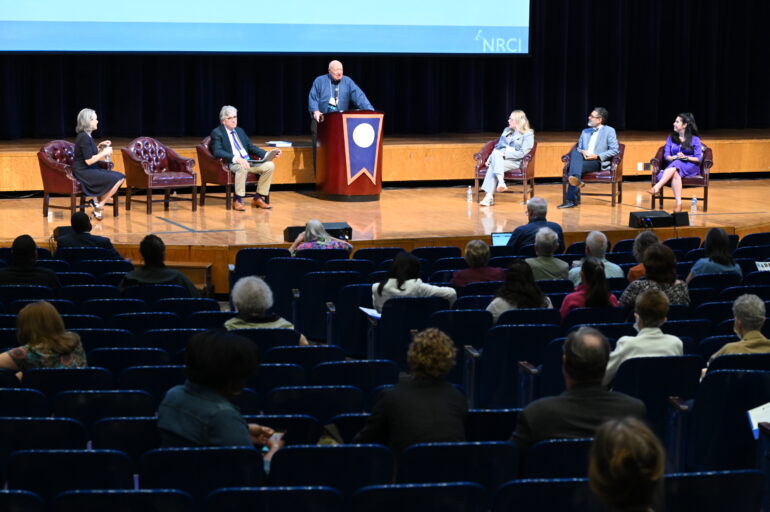The 21st annual NRCI conference examined the physical and emotional toll of stress and anxiety and how to ease the harm.
The Naomi Ruth Cohen Institute for Mental Health Education (NRCI) held its 21st annual community mental health conference on June 10, 2023, at Evanston Township High School. This year’s theme was “Untying the Human Knot: Managing Stress and Anxiety in Today’s World.” The event began with a panel presentation, during which speakers addressed the individual and societal causes and effects of anxiety, which impacts people of all ages and backgrounds, the majority of whom may not suffer from a psychological disorder.
Most ambitious yet
Institute co-founder Larry Cohen opened the conference—which he described as the most ambitious one yet for the institute that was formed to remove the stigma attached to mental illness. Speaking of his daughter who lived with bipolar disorder and died by suicide, he says, “That had been a horror and a real terror in Naomi’s life, and our weapon of attack was through education.”
Following Cohen, NRCI Executive Director Tracy Levine, MSW, provided an update on the institute’s initiatives. Since June 1, 2021, more than 3,000 people have participated in education sessions and trainings at more than 100 events, including those focused on suicide prevention and mental health first aid. In Evanston, Illinois, NRCI has collaborated to train 103 teens, aged 15 to 18, and a total of 363 mental health first aid providers across a wide range of organizations from the City of Evanston to City Colleges of Chicago. “We look forward to maintaining these relationships while we continue to grow and expand our offerings in the future,” Levine says.
Untying the knot
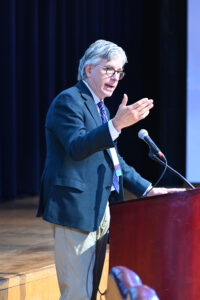
Mark Reinecke, Ph.D., professor emeritus of psychiatry and behavioral sciences at Northwestern University’s Feinberg School of Medicine, began the panel discussion with a call to action: “If each of you take something that you’ve learned here today and save one person’s life, that will be a remarkable thing that will resonate through the generations.”
In keeping with this year’s conference theme, Dr. Reinecke read from a favorite book, “The Ashley Book of Knots,” on how to untangle a snarled rope: “Keep the snarl open and loose at all times and do not pull on the end; permit it to unfold itself. As the process is continued to the end, the end will gradually emerge. No snarl or knot is too complicated to be solved by this method; only patience is required.”
Fight or flight
The panel’s first speaker, Paula Young, Ph.D., senior clinical director at Rogers Behavioral Health, addressed the evolutionary dilemma at the heart of our reactions to stress and anxiety. “Your whole body is made to be able to survive an attacker or a saber-toothed tiger,” Dr. Young says. “But what happens if you’re in a Zoom meeting and somebody asks you a question in front of your boss? You perceive it as a threat, and your fight or flight kicks in. It’s not going to be really adaptive.”
To illustrate this point, Dr. Young offered a list of physical symptoms that may be caused by stress and anxiety, including hypertension, high cholesterol, coronary heart disease, stroke, obesity, autoimmune diseases, and migraines. To address these
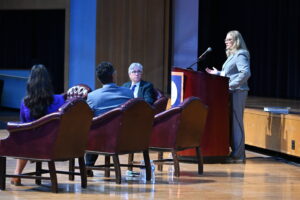
harmful effects, Dr. Young recommends a combined psychological and physical approach, beginning with a cognitive behavioral therapeutic response that assesses a patient’s interpretation of a given situation and which factors govern those interpretations. Second, she encourages a range of relaxation techniques, including deep abdominal breathing, progressive muscle relaxation, and meditation.
“It’s OK to do these things imperfectly,” Dr. Young says. “They might not feel natural either, but you can learn how to do them so that they do.”
Anxiety in a connected world
In his more than 20 years doing therapeutic work, Orson Morrison, Psy.D., associate director of DePaul University Counseling & Psychological Services, has come to understand that our overall wellness is affected by a variety of factors, including home life, community, and environmental conditions.
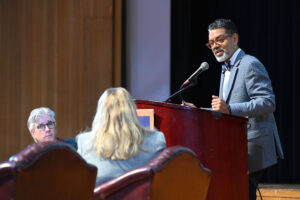
“As human beings, we have a profound need to connect with ourselves, with other people, and with the world around us,” Dr. Morrison says. “These connections help us to feel safe and also to co-regulate with each other.” When these connections are broken, however, individuals within a community can suffer, and those in lower socioeconomic groups are more likely to suffer more from these disruptions in society. Recently, these breakdowns have included the COVID-19 pandemic, racial trauma, attacks on LGBTQIA+ populations, gun violence, and climate change.
As members of a larger community, Dr. Morrison asks us to take stock of the anxiety we feel. “What is that call to action that our stress and anxiety is asking for?” he asks. “What are the changes that we need to achieve here collectively, as a group, to make this world feel safer for ourselves, for our communities, for our children, and for future generations to come?”
From an anxious childhood
Each NRCI conference features a lived-experience speaker. This year, Gabriela Diaz, a program coordinator for Erasing the Distance and a Chicago-based actor, teaching artist, and mental health advocate, described her lifelong struggles with anxiety, though her condition was not diagnosed until she was an adult. “Growing up as a Mexican American, we didn’t have a word for anxiety in my family,” she says.
She remembers staying up all night at the age of 4, crying because she and her parents were going to die someday, and waking up at 3 a.m. to do her third-grade math homework. After being called a drama queen by her siblings and co-workers, Diaz took up theater. “Suddenly, these giant emotions that I had been containing finally had a place where they could air out, and they could take up space,” Diaz says.
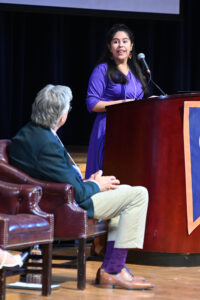
It was not until Diaz entered into therapy at the age of 26 that she was diagnosed with generalized anxiety disorder. “I finally earned my badge of anxiety,” she says. In the years since then, Diaz has applied her talent as teaching artist to “disarm stigma through the power of storytelling.”
Room for discussion
This year, the NRCI event organizers added a third hour of breakout sessions to accommodate a greater range of topics and approaches. Sessions such as “Principles and Practices for Cultivating Emotional Balance” and “Spiritual Practices for Stress Management” allowed professionals to compare notes and earn a continuing education unit (CEU) that educators and clinicians need to maintain their certifications. They were also an opportunity for the general public to learn more about current conversations regarding mental illness. One attendee–a speech therapist–said she came to the conference to support her sister who suffers from depression. “She’s looking to see what’s out there,” she says.
Another attendee, a retired addiction counselor, says, “I come every year. I used to come for the CEUs, but I’ve kept coming because the topics are so interesting, and I like that it’s for everyone.”
NRCI by the numbers

*Participants may not be unique as they may participate in more than one education offering
**Events may have been hosted by NRCI, or one on which we collaborated or were invited to present.
To learn more about initiatives and programs at The Chicago School, fill out the form below.

